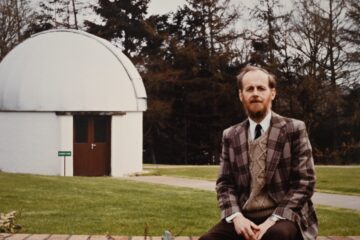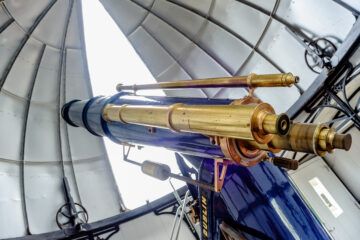Have you ever wondered what the stars are made of? It’s not like we can jump on a spaceship, visit them, and, using a special bucket and spade, take a sample from their surface to bring back to the lab for analysis, as a geologist or biologist might do. For one, humans cannot currently travel to other stars. Supposing this was somehow possible, it still wouldn’t be the best idea to approach the surface of a star: their temperatures are well over a thousand degrees. How, then, do we know what the stars are made of? We know this thanks to the work of Cecilia Payne-Gaposchkin.
This year, 2025, marks the 100 year anniversary of the publication of the PhD thesis of Cecilia Payne[1]. In her revolutionary work, Cecilia analysed the light of over 100 stars and measured, for the first time, what they are made of [1,2]. She found that they are mainly composed of hydrogen and helium. This finding contradicted what was believed at the time, as it was then accepted that stars were made of the same elements as Earth, like silicon and iron, and in the same proportions too. Her results were initially rejected by the community. It was not until later that independent studies confirmed her groundbreaking results, which have since paved the way for astrophysics as we study it today.
Cecilia was born in England in 1900. While studying physics and chemistry in Cambridge University, she attended a lecture given by famous astronomer Arthur Eddington. This lecture fascinated her, and, from then on, she knew that astrophysics was her calling. She finished her studies; however, she did not receive a degree as Cambridge did not award degrees to women at the time. Despite this setback she moved to the United States in 1923 to carry out her research at Harvard under the supervision of Harlow Shapley[2].
Cecilia studied the spectra of stars. A spectrum is what you see when you split up the light of a star. For example, a rainbow is technically the spectrum of the Sun, as the raindrops in the sky split up its white light into its component colours. Think of the cover art of the Dark Side of the Moon by Pink Floyd, except in this case, they used a glass prism instead of a raindrop to split up the Sun’s light. The spectrum we observe from a star is the light that it has emitted, which has passed through its atmosphere, traversed the emptiness of space, and reached our telescopes, where it has been split up (as Pink Floyd did in 1973 for their album cover) and recorded in our detectors.
The key stage of this journey occurs when the light passes through the atmosphere of the star. Their atmospheres, like Earth’s, consist of many, many atoms. An atom is a tiny particle consisting of a nucleus of protons and neutrons that is orbited by electrons. The electrons orbit the nucleus similar to how the planets in the Solar System orbit the Sun. What makes atoms interesting is that each one absorbs and re-emits very specific wavelengths, or colours, of light. This is due to the different numbers of protons, neutrons, and electrons in each atom. In that sense, each atom has its own unique fingerprint that we see when we observe its spectrum.
The atmosphere of a star will therefore absorb specific colours of light, and the combined absorption pattern we observe will be different depending on what types of atoms are present. These absorption features are called spectral lines, as they appear as dark lines in the continuous spectrum of a star. A sketch of a spectrum is shown in Figure 2 below. By cross matching the patterns of spectral lines produced by individual atoms, we can learn what is present in the stellar atmosphere from its spectrum. In this sense, a spectrum presents a unique puzzle, and it is up to astronomers to solve it.

Figure 2: The spectrum we observe from a star is a combination of the different atoms present in its atmosphere. Image Credit: Ciarán Furey.
In a star’s atmosphere, the temperature and pressure play a huge role in determining the patterns of lines we see. When it is hot enough, atoms can lose electrons. This is called ionisation. The fingerprint of an ionised atom looks completely different to that of its neutral form. The concept of ionisation was the key idea explored in Cecilia’s thesis. Her work was revolutionary because she used the recently developed ideas of Saha (1920) and Fowler and Milne (1923 and 1924) to show how the conditions in a star’s atmosphere influence the absorption patterns we observe in its spectrum.
Cecilia analysed the spectra of over 100 stars, studying more than 100 spectral lines in each. From the spectra, Cecilia could infer the temperature, pressure and ionisation state in the star’s atmosphere, and, from this, she determined the abundance of the elements. She used this method to calculate the abundances in the atmosphere of the Sun. The Sun’s spectrum is shown in Figure 3. This image was hand drawn by the great physicist Joseph von Fraunhofer more than 100 years before Cecilia carried out her pioneering research.

Figure 3: The spectrum of the Sun and its spectral lines, hand drawn by Fraunhofer in 1817. Each line represents light that has been absorbed by different atoms in the atmosphere of the Sun. Image Credit: Deutches Museum.
The bar chart in Figure 4 shows her abundance determinations of different atoms in the Sun’s atmosphere. Her findings show that the Sun is made mostly of hydrogen and helium: there are roughly one million times more of these atoms than there are, say, silicon and iron atoms. On the other hand, atoms like silicon, oxygen, and iron are the dominant species in the Earth’s crust. Realising that the composition of the stars was different to that of the planets blew open the field of astrophysics, and our view of the Universe. Planets and stars are now fundamentally different objects, not the same things that are at different temperatures. If stars are not like the Earth, then what are they? What is going on in their interiors? How are they so hot? This was the first time an extensive study of a specific topic in astrophysics was conducted at the Harvard Observatory, meaning that, in 1925, Cecilia was the first person to ever receive a PhD certificate in the subject from Harvard.

Figure 4: The abundances of elements in the Sun as determined by Cecilia in her 1925 PhD thesis. She found that it is mostly comprised of hydrogen and helium – the two lightest elements in the Universe. Image Credit: Ciaran Furey.
This discovery came with a cost. Cecilia’s result conflicted with common belief at the time, where it was accepted that stars were made of the same elements in the same proportions as observed on Earth. Her results were rejected by many, such as the great astronomer Henry Norris Russell. Even Cecilia felt obliged to state that her results were “almost certainly not real”.
Little did both Cecilia and the rest of the astronomical community realise that she was in fact correct. Independent studies that took place after her thesis confirmed her results. For the first time, she linked the atomic fingerprints seen in stellar spectra to the abundance of elements. This laid the foundations for modern stellar spectroscopy. Today, using far more advanced tools, we can tell not only what stars are made of, but also how fast they are spinning, how hot they are at their surface, and also whether there are hidden companions orbiting them.
Spectroscopy is used every day by the astronomers here at Armagh Observatory. The origins of the spectra we analyse range from the most massive stars in the Universe, to the comets in our solar system, to very peculiar populations of stars, as we look to build a complete picture of the stars and the Universe. All of this would not have been possible without the work of Cecilia Payne. Her story is an example for anyone who thinks they would like to pursue a career in astrophysics: that, with perseverance, hard work, and a positive attitude, anything is possible.
References:
Spears, S. (2022), The First Lady of Harvard’s Observatory Hill: Cecilia Payne-Gaposchkin, American Astronomical Society, https://aas.org/posts/news/2022/04/month-astronomical-history-april-2022
Payne, Cecilia H. (1925), Stellar Atmospheres; a Contribution to the Observational Study of High Temperature in the Reversing Layers of Stars (PhD thesis). Radcliffe College
Sobel, D. (2016), The Glass Universe; The Hidden History, of the Women Who Took the Measure of the Stars, Fourth Estate
[1] Cecilia married a man named Sergei Gaposchkin later in life, so the double-barrelled surname is used interchangeably. In this article, we refer to her as Cecilia Payne.
[2] Harlow Shapley was the acting director of Armagh Observatory in 1959.




0 Comments